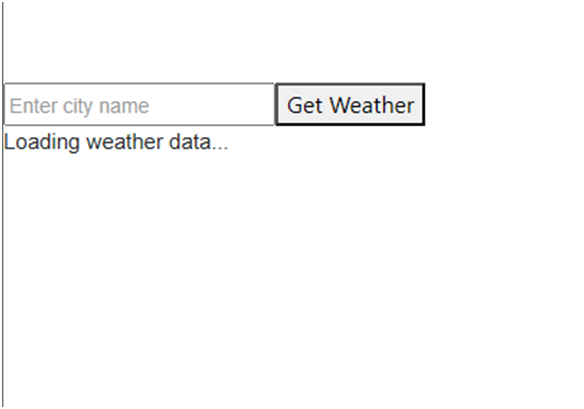Skill Development Course - NodeJs Lab Manual - (LAB PROGRAMS)
Notice: Undefined index: title in /home/u681245571/domains/studyglance.in/public_html/labprograms/nodejsdisplay.php on line 89
Aim:
☛
Solution :
Step 1: Create an OpenWeatherMap Account and Generate API Key
- Visit the OpenWeatherMap website (https://openweathermap.org/) and click on "Sign Up" or "Log In" to create an account or log into your existing account.
- Once logged in, navigate to your account dashboard.
- From the dashboard, locate my API Keys section and click on "Create Key" or "API Keys" to generate a new API key.
- Provide a name for your API key (e.g., "WeatherApp") and click on the "Generate" or "Create" button.
- Your API key will be generated and displayed on the screen. Make sure to copy it as we will need it later.
Locate API key

Step 2: Set up a new React project
- Open your terminal or command prompt.
- Run the following command to create a new React project:
npxcreate-react-app weather-app
- Once the project is created, navigate into the project directory:
cd weather-app
Step 3: Install required packages
In the project directory, install the necessary packages by executing the following command
npm install axios
We will use the Axios library to make HTTP requests to the OpenWeatherMap API.
Step 4: Create a Weather component
- Inside the "src" directory, create a new file called "Weather.js" and open it in your code editor.
- Add the following code to define a functional component named Weather:
import React, { useEffect, useState } from 'react';
import axios from 'axios';
const Weather = () => {
const [city, setCity] = useState('');
const [weatherData, setWeatherData] = useState(null);
const fetchData = async () => {
try {
const apiKey = 'c97c0c1086d42990e89d64d76f50bb61'; // Replace with your OpenWeatherMap API key
const response = await axios.get(
'https://api.openweathermap.org/data/2.5/weather?q=${city}&units=metric&appid=${apiKey}'
);
setWeatherData(response.data);
console.log(response.data); //You can see all the weather data in console log
} catch (error) {
console.error(error);
}
};
useEffect(() => {
fetchData();
}, []);
const handleInputChange = (e) => {
setCity(e.target.value);
};
const handleSubmit = (e) => {
e.preventDefault();
fetchData();
};
return (
<div>
<form onSubmit={handleSubmit}>
<input
type="text"
placeholder="Enter city name"
value={city}
onChange={handleInputChange}
/>
<button type="submit">Get Weather</button>
</form>
{weatherData ? (
<>
<h2>{weatherData.name}</h2>
<p>Temperature: {weatherData.main.temp} C</p>
<p>Description: {weatherData.weather[0].description}</p>
<p>Feels like : {weatherData.main.feels_like} C</p>
<p>Humidity : {weatherData.main.humidity}%</p>
<p>Pressure : {weatherData.main.pressure}</p>
<p>Wind Speed : {weatherData.wind.speed}m/s</p>
</>
) : (
<p>Loading weather data...</p>
)}
</div>
);
};
export default Weather;
Replace {YOUR_API_KEY} in the API URL with the API key you generated from OpenWeatherMap.
Step 5: Connect the Weather component to your app.
- Open the "App.js" file in the "src" directory.
- Replace the existing code with the following code:
import React from'react';
import Weather from'./Weather';
const App = () => {
return (
<div>
<h1>Weather Forecast App</h1>
<Weather />
</div>
);
};
exportdefault App;
Your output should look like this:
Output :
Initial Screen

After Supply the City name

Related Content :
Skill Development Course - NodeJs Lab Programs
1) Build a responsive web application for shopping cart with registration, login, catalog and cart pages using CSS3 features, flex and grid. View Solution
2) Use JavaScript for doing client – side validation of the pages implemented in the experiment View Solution
3) Explore the features of ES6 like arrow functions, callbacks, promises, async/await. Implement an application for reading the weather information from openweathermap.org and display the information in the form of a graph on the web page. View Solution
4) Develop a java stand alone application that connects with the database (Oracle / mySql) and perform the CRUD operation on the database tables. View Solution
5) Create an xml for the bookstore. Validate the same using both DTD and XSD. View Solution
6) Create a custom server using http module and explore the other modules of Node JS like OS, path, event. View Solution
7) Develop an express web application that can interact with REST API to perform CRUD operations on student data. (Use Postman) View Solution
8) Create a service in react that fetches the weather information from open weathermap.org and the display the current and historical weather information using graphical representation using chart.js View Solution
9) Create a TODO application in react with necessary components and deploy it into github. View Solution